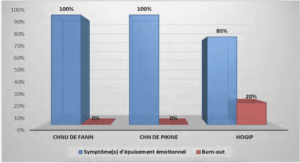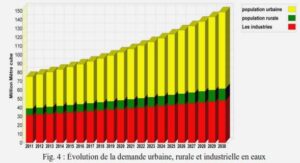Application aux glaciations amazoniennes des moyennes latitudes
Comme l’illustrent les chapitres précédents, la connaissance du cycle des poussières et du cycle de l’eau martien s’est considérablement accrue au cours de la dernière décen- nie. En plus de ces informations sur le climat actuel, l’étude récente de très nombreuses structures géologiques donnent de précieuses informations sur le climat passé de la pla- nète. En particulier, les moyennes latitudes Nord de Mars sont connues pour abriter de larges « écoulements visqueux » (voir la figure 6.1), aujourd’hui clairement identifiés comme étant des glaciers rocheux. Il a fallu attendre presque 30 ans pour confirmer cette origine glaciaire, grâce au radar SHARAD N. La scène fait 14 km de large, et le dénivelé est d’environ 1 km. Image CTX (Context Camera à bord de MRO) et topographie MOLA, sans exagération verticale. Image réalisée et aimable- ment envoyée par James Dickson. Une analyse géomorphologique détaillée de ces régions révèlent l’existence passéede dépôts glaciaires atteignant 800 m d’épaisseur (Dickson et al., 2008; Head et al., 2010), formés lors de l’Amazonien supérieur. La glace d’eau étant aujourd’hui instable en sur- face dans ces régions, des changements climatiques de grande ampleur ont eu lieu dans le passé pour expliquer de tels dépôts, et ces changements peuvent être simuler grâce au modèle de climat global. Dans ce chapitre, nous avons donc cherché à expliquer l’origine de ces glaciations, en modifiant les paramètres orbitaux de la planète, les sources de va- peur d’eau, mais également en changeant l’opacité de la couche de poussière.
En effet, si le GCM du LMD s’était révélé capable d’expliquer la présence de zones glaciaires sur les flancs des volcans tropicaux, à l’Est du bassin d’Hellas (Forget et al., 2006), et aux hautes latitudes (Levrard et al., 2004), l’origine des spectaculaires glaciers de l’hémisphère Nord restait énigmatique, peut-être parce que la sensibilité à la quantité de poussière atmo- sphérique n’avait pas été explorée. En effet, des simulations utilisant un cycle des poussières intéractif montrent que lorsque l’obliquité de la planète croît, la circulation méridionale est accentuée, et la quan- tité de poussière mise en suspension augmente (Newman et al., 2005). Nous avons donc également exploré la sensibilité du climat martien à l’opacité de poussière, et décou- vert un régime climatique permettant l’accumulation de grandes quantités de glace aux moyennes latitudes. Cette découverte est présentée dans ce chapitre. Recent geological observations in the northern mid-latitudes of Mars show evidence for past glacial activity during the late Amazonian, similar to the integrated glacial land- systems in the Dry Valleys of Antarctica. The large accumulation of ice (many hundreds of meters) required to create the observed glacial deposits points to significant atmos- pheric precipitation, snow and ice accumulation, and glacial flow. In order to unders- tand the climate scenario required for these conditions, we used the LMD (Laboratoire de Météorologie Dynamique) Mars GCM (General Circulation Model), which is able to reproduce the present-day water cycle, and to predict past deposition of ice consistent with geological observations in many cases. Prior to this analysis, however, significant mid-latitude glaciation had not been simulated by the model, run under a range of para- meters.
In this analysis, we studied the response of the GCM to a wider range of orbital confi- gurations and water ice reservoirs, and show that during periods of moderate obliquity (ǫ = 25-35 thern mid-latitudes occurs if water ice deposited on the flanks of the Tharsis volcanoes at higher obliquity is available for sublimation. We find that high dust contents of the atmosphere increase its water vapor holding capacity, thereby moving the saturation region to the northern mid-latitudes. Precipitation events are then controlled by topo- graphic forcing of stationary planetary waves and transient weather systems, producing surface ice distribution and amounts that are consistent with the geological record. Ice accumulation rates of ∼ 10 mm yrEvidence for the influence of non-polar ice deposition on geomorphic features and processes became available as a result of the comprehensive global coverage provided by the Viking Orbiter imaging system. For example, Squyres (1978, 1979) attributed a variety of landforms (e.g., lobate debris aprons, lineated valley fill, concentric crater fill, terrain softening) to the creep of the martian regolith aided by the deformation of ground ice at latitudes higher than ∼ 30. Other workers (e.g., Lucchitta, 1981) noted that many of these features appeared to represent not just ice-assisted creep, but rather more substan- tial glacial-like flow. More recently, new high-resolution data have shown the presence of deposits interpreted to represent the remnants of extensive glacial landsystems that for- med in the parts of the northern mid-latitudes during the Amazonian (e.g., Head et al., 2006b,a; Head and Marchant, 2006; Dickson et al., 2008). These recent analyses show the widespread development of valley glaciers, piedmont glaciers, plateau glaciation, and the development of extensive glacial landsystems across the northern mid-latitudes (see Fig. 6.2). Detailed examination of these deposits shows that ice may have reached thi- cknesses of up to 2-2.5 km in some regions along the dichotomy boundary (e.g., Head et al., 2006b,a; Dickson et al., 2008). Clearly, the current atmosphere and climate do not permit the accumulation of snow and ice at the level necessary to produce such deposits. This raises the question : Under what past climate conditions could the accumulation of snow and ice occur to produce the types of glacial deposits seen in the northern mid- latitudes ?




